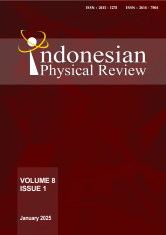THE APPLICATION OF PLASTIC FIBER OPTIC SENSOR AS BLOOD PRESSURE MONITORING
DOI:
10.29303/ipr.v8i1.395Downloads
Abstract
Continuous blood pressure monitoring is essential for early hypertension prevention and cardiovascular disease diagnosis. Traditional methods are unsuitable for long-term use due to discomfort and limited portability. This study presents a tapered plastic fiber optical sensor (PFOS) as a sustainable, non-invasive solution for continuous monitoring. The PFOS system employs a light modulator based on mechanical waves to detect arterial pressure changes, utilizing an infrared light source (940 nm). The cuffless design includes four configurations: Bend, Bend with 1 Scratch, Bend with 3 Scratches, and Straight with 3 Scratches. The Bend with 1 Scratch configuration demonstrated superior performance, achieving 99.84% accuracy, a mean absolute error (MAE) of 0.1564, a linearity of 0.9999, and a sensitivity of 2.9997 Hz/dBm. Experimental validation involved testing radial and brachial arteries. Blood pressure estimates from Pulse Transit Time (PTT) were compared to a standard sphygmomanometer. On the radial artery, the Bend with 1 Scratch configuration achieved the best results, with the lowest MAE (1.72 for SBP, 2.39 for DBP) and highest accuracy (98.30% for SBP, 96.56% for DBP). The Straight with 3 Scratches configuration performed best on the brachial artery, with an MAE of 2.81 for SBP and 5.11 for DBP, and accuracies of 97.21% for SBP and 92.67% for DBP. The PFOS system offers a promising option for continuous monitoring in clinical and home settings.
Â
Keywords:
Blood Pressure, Pulse Transit Time, Cuffless Design, Configuration Sensor, Tapered PFOSReferences
D. Aune, Y. Mahamat-Saleh, E. Kobeissi, T. Feng, A. K. Heath, and I. Janszky, “Blood pressure, hypertension and the risk of atrial fibrillation: A systematic review and meta-analysis of cohort studies,†Eur J Epidemiol, vol. 38, no. 2, pp. 145–178, Feb. 2023.
R. Singh and others, “Hypertension and stroke in Asia: Prevalence, control and strategies in developing countries for prevention,†J Hum Hypertens, vol. 14, no. 10–11, pp. 749–763, Oct. 2000.
L. Minna, B. Ferdinando, C. Ronald, G. Richard, J. Jared, and N. Mingming, “Electronic diary monitoring for hypertension post stroke,†Journal of Hypertension Management, vol. 9, no. 1, p. 73, Jun. 2023.
S. S. Franklin and N. D. Wong, “Hypertension and cardiovascular disease: Contributions of the Framingham heart study,†Glob Heart, vol. 8, no. 1, pp. 49–57, Mar. 2013.
I. N. Wirakhmi and D. Novitasari, “Pemberdayaan Kader Pengendalian Hipertensi,†Jurnal Altifani Penelitian dan Pengabdian Kepada Masyarakat, vol. 1, no. 2, pp. 240–248, 2021, doi: 10.25008/altifani. v1i3.162.
American Heart Association (AHA), “Understanding Blood Pressure Reading,†2022. [Online]. Available: https://www.heart.org/en/health-topics/high-blood-pressure/understanding-blood-pressure-readings
World Health Organization (WHO), “Hypertension,†2023. [Online]. Available: https://www.who.int/news-room/fact-sheets/detail/hypertension
Kementerian Kesehatan Republik Indonesia (Kemenkes RI), “Hipertensi Penyakit Paling Banyak Diidap Masyarakat,†2019. [Online]. Available: https://www.kemkes.go.id/article/view/19051700002/hipertensi-penyakit-paling-banyak-diidap-masyarakat.html
C. Goodman and G. Kitchen, “Measuring Arterial Blood Pressure,†Anaesthesia & Intensive Care Medicine, vol. 22, pp. 49–53, 2021.
L. Maharani, “Implementasi Pengukuran dan Klasifikasi Tekanan Darah Berdasarkan Pulse Transit Time Menggunakan Metode Transformasi Wavelet dan Support Vector Machines,†2016.
B. S. Alpert, D. Quinn, and D. Gallick, “Oscillometric blood pressure: A review for clinicians,†Journal of the American Society of Hypertension, vol. 8, no. 12, pp. 930–938, Dec. 2014.
C. F. Babbs, “The origin of Korotkoff sounds and the accuracy of auscultatory blood pressure measurements,†Journal of the American Society of Hypertension, vol. 9, no. 12, pp. 935–950, Dec. 2015.
C. Qiu, T. Wu, F. Heydari, J.-M. Redouté, and M. R. Yuce, “Wearable blood pressure monitoring based on bio-impedance and photoplethysmography sensors on the arm,†in Proceedings of IEEE SENSORS, Oct. 2018, pp. 1–3.
S. Hoshide and others, “Pulse transit time-estimated blood pressure: A comparison of beat-to-beat and intermittent measurement,†Hypertension Research, vol. 45, no. 6, pp. 1001–1007, Jun. 2022.
S. Rao, K. Adithi, and S. C. Bangera, “An experimental investigation on pulse transit time and pulse arrival time using ECG, pressure and PPG sensors,†Medical Novel Technologies and Devices, vol. 17, Mar. 2023.
S. Mehta, N. Kwatra, M. Jain, and D. McDuff, “Can’t take the pressure? Examining the challenges of blood pressure estimation via pulse wave analysis,†arXiv preprint arXiv:2304.14916, 2023.
L. Li, Y. Li, L. Yang, F. Fang, Z. Yan, and Q. Sun, “Continuous and Accurate Blood Pressure Monitoring Based on Wearable Optical Fiber Wristband,†IEEE Sens J, vol. 21, no. 3, pp. 2642–2650, 2021.
Z. B. Zhou et al., “Wearable Continuous Blood Pressure Monitoring Devices Based on Pulse Wave Transit Time and Pulse Arrival Time: A Review,†Mar. 01, 2023, MDPI. doi: 10.3390/ma16062133.
S. Rizkiyah, “Perancangan Sensor Beban Menggunakan Serat Optik Berstruktur Multimmode-Singlemode-Multimode (MSM) untuk Sistem Weight In Motion (WIM),†2016.
A. K. Arifin, M. Lebang, S. Yunus, I. Dewang, I. Idris, and D. Tahir, “Measurement heart rate based on plastic optical fiber sensor,†in Journal of Physics: Conference Series, Institute of Physics Publishing, May 2019, p. 12074. doi: 10.1088/1742-6596/1170/1/012074.
S. H. Mardiyati, “Measurement of Blood Pressure Using Fiber Bragg Grating Sensor,†IEEE Sens J, vol. 17, no. 5, pp. 1527–1532, 2017.
S. Chino, H. Ishizawa, S. Koyama, and K. Fujimoto, “Influence of Installing Method on Pulse Wave Signal in Blood Pressure Prediction by FBG Sensor,†in 2018 IEEE International Symposium on Medical Measurements and Applications (MeMeA), IEEE, Jun. 2018, pp. 1–6. doi: 10.1109/MeMeA.2018.8438626.
Y. Haseda, J. Bonefacino, H. Y. Tam, S. Chino, S. Koyama, and H. Ishizawa, “Measurement of pulse wave signals and blood pressure by a plastic optical fiber FBG sensor,†Sensors, vol. 19, no. 23, Dec. 2019, doi: 10.3390/s19235088.
J. Bonefacino and others, “Ultra-fast polymer optical fibre Bragg grating inscription for medical devices,†Light Sci Appl, vol. 7, no. 3, p. 17161, Mar. 2018, doi: 10.1038/lsa.2017.161.
M. F. Farobi, “Rancang Bangun Balistokardiograf Berbasis Sensor Serat Optik Singlemode-Multimode-Singlemode (SMS),†2023.
C. P. Mayoral, “Fiber Optic Sensors for Vital Signs Monitoring: A Review of Its Practicality in the Health Field,†Biosensors (Basel), vol. 11, no. 2, p. 58, 2021.
Y.-H. Kao, “Towards maximizing the sensing accuracy of an cuffless, optical blood pressure sensor using a high-order front-end filter,†Microsystem Technologies, vol. 24, no. 11, pp. 4621–4630, 2018.
British Hypertension Society (BHS), “Guidelines for management of hypertension,†2004.
Widianto, A. A., Romdhoni, M. F., Karita, D., & Purbowati, M. R.. Hubungan Pola Makan dan Gaya Hidup Dengan Angka Kejadian Hipertensi Pralansia dan Lansia di Wilayah Kerja Puskesmas I Kembaran. Junal Unimus, Vol. 1 No.5, 2018.
C. Peng, M. Chen, H. K. Sim, Y. Zhu, and X. Jiang. “Non-invasive and nonocclusive blood pressure monitoring via a flexible piezo-composite ultrasonic sensor,†IEEE Sensors J., vol. 21, no. 3, pp. 2642–2650, Feb. 2021.
X. Li (2019) Continuous Blood Pressure Monitoring Using Brillouin Optical Time-Domain Analysis. Optics Express, vol. 27, no. 3, pp. 2863-2875
T. Nguyen. (2021). Blood Pressure Estimation Using Mach-Zehnder Interferometer Based Fiber Optic Sensor. Biomedical Optics Express, vol. 12, no. 4, pp. 1789-1798
License

This work is licensed under a Creative Commons Attribution-NonCommercial-ShareAlike 4.0 International License.
Authors who publish with Indonesian Physical Review Journal, agree to the following terms:
- Authors retain copyright and grant the journal right of first publication with the work simultaneously licensed under a Creative Commons Attribution-ShareAlike 4.0 International Licence (CC BY SA-4.0). This license allows authors to use all articles, data sets, graphics, and appendices in data mining applications, search engines, web sites, blogs, and other platforms by providing an appropriate reference. The journal allows the author(s) to hold the copyright without restrictions and will retain publishing rights without restrictions.
- Authors are able to enter into separate, additional contractual arrangements for the non-exclusive distribution of the journal's published version of the work (e.g., post it to an institutional repository or publish it in a book), with an acknowledgment of its initial publication in Indonesian Physical Review Journal.
- Authors are permitted and encouraged to post their work online (e.g., in institutional repositories or on their website) prior to and during the submission process, as it can lead to productive exchanges, as well as earlier and greater citation of published work (See The Effect of Open Access).





